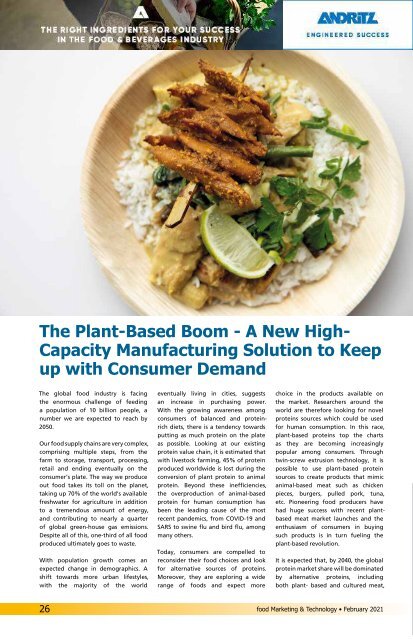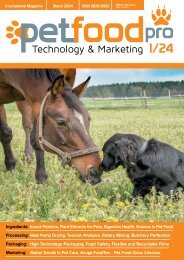food Marketing & Technology 1/2021
food Marketing & Technology is the international magazine for executives and specialists in the food industry.
food Marketing & Technology is the international magazine for executives and specialists in the food industry.
You also want an ePaper? Increase the reach of your titles
YUMPU automatically turns print PDFs into web optimized ePapers that Google loves.
Ingredients<br />
The Plant-Based Boom - A New High-<br />
Capacity Manufacturing Solution to Keep<br />
up with Consumer Demand<br />
The global <strong>food</strong> industry is facing<br />
the enormous challenge of feeding<br />
a population of 10 billion people, a<br />
number we are expected to reach by<br />
2050.<br />
Our <strong>food</strong> supply chains are very complex,<br />
comprising multiple steps, from the<br />
farm to storage, transport, processing,<br />
retail and ending eventually on the<br />
consumer’s plate. The way we produce<br />
out <strong>food</strong> takes its toll on the planet,<br />
taking up 70% of the world’s available<br />
freshwater for agriculture in addition<br />
to a tremendous amount of energy,<br />
and contributing to nearly a quarter<br />
of global green-house gas emissions.<br />
Despite all of this, one-third of all <strong>food</strong><br />
produced ultimately goes to waste.<br />
With population growth comes an<br />
expected change in demographics. A<br />
shift towards more urban lifestyles,<br />
with the majority of the world<br />
eventually living in cities, suggests<br />
an increase in purchasing power.<br />
With the growing awareness among<br />
consumers of balanced and proteinrich<br />
diets, there is a tendency towards<br />
putting as much protein on the plate<br />
as possible. Looking at our existing<br />
protein value chain, it is estimated that<br />
with livestock farming, 45% of protein<br />
produced worldwide is lost during the<br />
conversion of plant protein to animal<br />
protein. Beyond these inefficiencies,<br />
the overproduction of animal-based<br />
protein for human consumption has<br />
been the leading cause of the most<br />
recent pandemics, from COVID-19 and<br />
SARS to swine flu and bird flu, among<br />
many others.<br />
Today, consumers are compelled to<br />
reconsider their <strong>food</strong> choices and look<br />
for alternative sources of proteins.<br />
Moreover, they are exploring a wide<br />
range of <strong>food</strong>s and expect more<br />
choice in the products available on<br />
the market. Researchers around the<br />
world are therefore looking for novel<br />
proteins sources which could be used<br />
for human consumption. In this race,<br />
plant-based proteins top the charts<br />
as they are becoming increasingly<br />
popular among consumers. Through<br />
twin-screw extrusion technology, it is<br />
possible to use plant-based protein<br />
sources to create products that mimic<br />
animal-based meat such as chicken<br />
pieces, burgers, pulled pork, tuna,<br />
etc. Pioneering <strong>food</strong> producers have<br />
had huge success with recent plantbased<br />
meat market launches and the<br />
enthusiasm of consumers in buying<br />
such products is in turn fueling the<br />
plant-based revolution.<br />
It is expected that, by 2040, the global<br />
protein market share will be dominated<br />
by alternative proteins, including<br />
both plant- based and cultured meat,<br />
26<br />
<strong>food</strong> <strong>Marketing</strong> & <strong>Technology</strong> • February <strong>2021</strong>


















